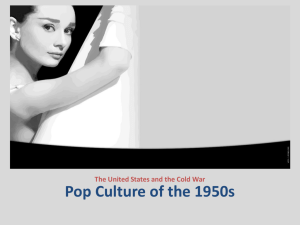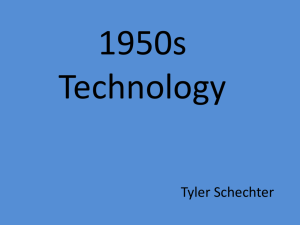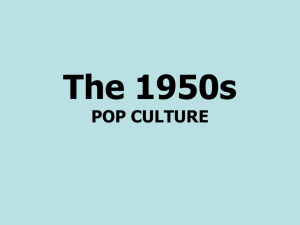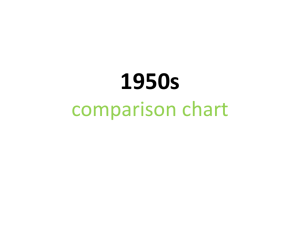Lesson 26-3: The Television Age
advertisement
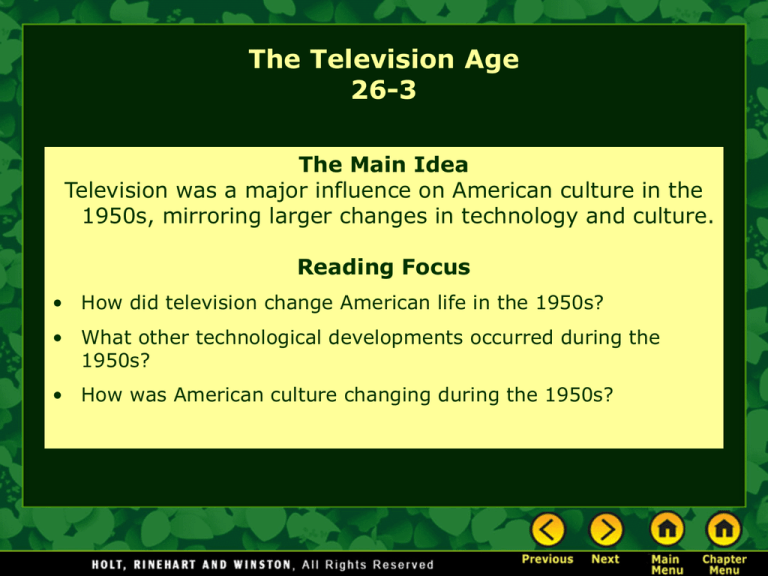
The Television Age 26-3 The Main Idea Television was a major influence on American culture in the 1950s, mirroring larger changes in technology and culture. Reading Focus • How did television change American life in the 1950s? • What other technological developments occurred during the 1950s? • How was American culture changing during the 1950s? Television in the 1950s • By the end of World War II, television was ready for home use. • Postwar consumers purchased the new device. – In 1950, 9 percent of U.S. households had televisions. – In 1960, 87 percent of U.S. households had televisions. • Television had an immediate impact on American culture. – On politics – In advertising • Some Americans questioned the effects of television— especially on children. Television Changes American Life • Politicians quickly realized that TV had great power to change their relationship with voters. Politics – Richard Nixon and the Checkers speech – Joseph McCarthy and the 1954 Army-McCarthy hearings • Advertisers realized that TV’s combination of pictures and sound gave it more persuasive power than radio. • At first, a single advertiser sponsored the Advertising broadcast of an entire program—for example, the Colgate Comedy Hour. • As the cost of producing TV shows rose, advertisers shifted to buying just one- or twominute segments during a show. Television Changes American Life • Lucille Ball was the star of a hugely popular comedy called the I Love Lucy show. Programming • Milton Berle’s popular program of comedy and music helped television get established. • American Bandstand appealed to the rock-androll crowd. • Howdy Doody • Soap operas, crime dramas, and game shows all got their start during the 1950s. Concerns about TV • Some were concerned about the effects of TV. • Congress looked into the effects of violent content on young viewers. • TV experienced a scandal in the late 1950s when the public discovered that a game show had been rigged. Click on the window to start video Other Technology in the 1950s Transistors • Developed in 1947, the transistor worked like the vacuum tubes in early computers but with several advantages. • Were smaller and did not break as often • Improved all kinds of electronics from radios to TVs to computers Computers • UNIVAC, built in 1951, was the first commercial computer. Salk Vaccine • Polio outbreaks were common in the early 1900s. • Huge computer— weighed 30,000 pounds and took up a room • Polio was contagious, spread quickly, and could be fatal. • Large companies and government agencies bought these computers. • In 1952 more than 57,000 people contacted polio. • The integrated circuit or computer chip was developed in 1958. • Jonas Salk developed a new polio vaccine. Iron Lung To Treat Polio Univac Penicillin • Alexander Fleming discovered penicillin American Culture in the 1950s Boom Times • United States was the world’s greatest economic power. • Baby boom during the 1950s • Consumerism was rampant, with new houses filled with new appliances with new cars in the driveways. • Employments was high and wages rose. Businesses • Franchise- the right to open a business using the parent companies brand name and stem • Conglomerates- a large corporation that owns many smaller companies that produce entirely different goods and services • Blue collar- produce goods • White collar- perform services American Culture in the 1950s Consumer Credit • Gas companies began offering credit cards • At end of 50’s American Express Card and Bank Americard (today called Visa) developed • Americans used credit cards to purchase washing machines, vacuums, and televisions. The Critics • Kenneth Galbraith called America the “affluent society” and criticized American for being overly focused on its own wealth. • Michael Harrington complained that the nation’s poor had been forgotten. – The Other America • William H. Whyte noted a loss of individuality among the growing class of business workers. Cultural Changes in the 1950s New Communities • Levittown was the most famous of the new suburban communities. • The U.S. population was beginning a shift in settlement to the so-called Sunbelt—the southern and western parts of the country. New Highways • During the 1950s the United States launched the Interstate Highway System—a network of high-speed roads for interstate travel. • This reinforced the United State’s commitment to cars and trucks as its main means of ground transportation. Youth Culture • Some called the Youth of 1950’s the silent generation – More leisure time than other generations Resurgence of Religion • • • • • 1954- “under God” added to the Pledge of Allegiance “In God We Trust” printed on U.S. money Slogans- family that prays together, stays together Dial a prayer 95% of Americans associated themselves with some kind of religious group • Billy Graham became a popular tv evangelist Men’s And Women’s Roles • Social roles were clearly defined • Dr. Spock- Common Sense Book of Baby and Child Care • Betty Friedan- wrote “The Feminine Mystique” The Art of Rebellion Art in the 1950s stressed rebellion against sameness and conformity. Film stars built images as rebels who defied social norms. •James Dean •Marlon Brando The 1950s witnessed the emergence of the Beat generation, who took the position of outsiders and rejected social norms.- called beatniks •Jack Kerouac Rock and roll represented the rebellion of young people. •Elvis Presley first on television Art of Rebellion • Rock Around the Clock • Johnny B. Good The Catcher and the Rye • Jerome David Salinger published stories based on his wartime experiences – The Catcher and the Rye • Teenager runs away from what he perceives as the artificial world of adults • Became a favorite coming of age story

